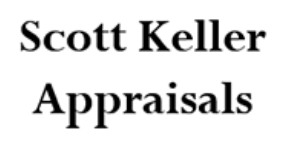A live weekly radio adventure through Indiana history with host Nelson Price.
Show airs live from noon to 1 p.m. ET each Saturday on WICR 88.7 FM in Indianapolis. Or install the WICR HD 1 app on your cell phone or computer and stream live from anywhere.
September 10, 2022
White River in Indy: historic navigability challenges
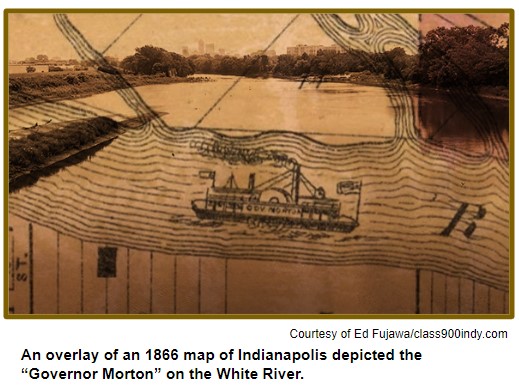
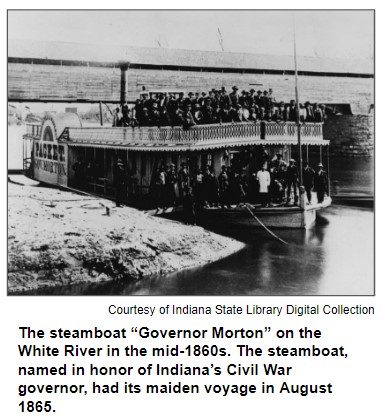 Could the White River make the new city of Indianapolis a major center for shipping in the 1820s? Could a steamboat arrive and depart in the 1830s, or would it get stuck on a sandbar? And, nearly 200 years later, has the depth of the waterway changed in the Indy metro area?
Could the White River make the new city of Indianapolis a major center for shipping in the 1820s? Could a steamboat arrive and depart in the 1830s, or would it get stuck on a sandbar? And, nearly 200 years later, has the depth of the waterway changed in the Indy metro area?
Hoosier History Live will plunge into these and other issues about the White River. Its west fork flows through Indianapolis, which was created in the wilderness of the 1820s to be the new state capital city. Many historic accounts discuss how state leaders assumed the White River would be navigable for a range of watercraft. When a steamboat called the "General Hanna" (its owner was Robert Hanna, a military commander) got stuck in 1831 on a sandbar just south of the city, where it remained for six weeks and became an object of ridicule, the challenges with navigability were obvious.
To share insights about that episode and other aspects related to the White River's navigability, Indianapolis attorney Ed Fujawa will be Nelson's guest. Ed is the creator of class900indy.com, a blog about city history that includes a recent, in-depth post (date of post: July 29, 2022) about this aspect of White River history. Ed has been a guest on previous Hoosier History Live shows, including, most recently, a program in May about the histories of Geist and Morse reservoirs.

"Later in 1866, the 'Morton' sank while moored at its wharf. The cause of the sinking was not located in any sources, and the wreck remained in place for months after the sinking," according to the class900indy blog.
Our show also will look at earlier accounts involving flatboats and keelboats (powered by oars and poles) that were seen on the White River in the 1820s. Ed notes that Gen. John Tipton, a state and civic leader, reported being on the banks of the river (in the area that's now White River State Park) to see the arrival of a small flatboat and canoe around the time the site for Indianapolis was selected.
 Ed notes that state and local leaders considered the river to be navigable "despite the reality of the White River's water levels often being far too low to support heavier water traffic, in addition to numerous sandbars, log jams and snags." Elsewhere in his blog, Ed points out: "The river today is much different than the river of the 1800s. Several dams exist, creating deeper sections at certain points, while the flow of the river has been redirected for industrial and residential use. The river is still susceptible to log jams and snags, and even during normal or higher water periods there are still numerous shallow sections and 'ripples' which would make upstream navigation difficult."
Ed notes that state and local leaders considered the river to be navigable "despite the reality of the White River's water levels often being far too low to support heavier water traffic, in addition to numerous sandbars, log jams and snags." Elsewhere in his blog, Ed points out: "The river today is much different than the river of the 1800s. Several dams exist, creating deeper sections at certain points, while the flow of the river has been redirected for industrial and residential use. The river is still susceptible to log jams and snags, and even during normal or higher water periods there are still numerous shallow sections and 'ripples' which would make upstream navigation difficult."
After the "General Hanna" steamboat became stuck on a sandbar upon departing from Indianapolis in 1831, the notion of having it travel on the White River often was ridiculed as "Hanna's Folly". A few days earlier, though, "the arrival of the steamboat caused great excitement in Indianapolis," according to the Encyclopedia of Indianapolis. Celebrations had included the firing of a cannon.
Jumping about 80 years later to the early 1900s, our guest Ed Fujawa notes that steam-powered pleasure craft made brief excursion trips on the White River from such sites as Riverside Amusement Park. He adds: "These vessels were also limited to short sections of the river due to shallow areas of the river, bridges and dams, and apparently were used only for passenger rides, and not cargo or significant transport."
A bear pit at Riverside Amusement Park in the early 1900s and other (clearly unfortunate) animal attractions were the focus of a Hoosier History Live show with Ed in 2021. Riverside Amusement Park opened in 1903 and was the dominant entertainment center of its kind in central Indiana until it closed after more than 60 years.Your contributions helps keep Hoosier History Live on the air, on the web and in your inbox!

We'd like to thank the following recent individual contributors who make this show possible. For a full list of contributors over the years, visit Support the Show on our website.
- Florence and John Stanton
- Aleta Hodge
- Peggy Hollingsworth
- Lorraine Phillips Vavul
- Margaret Smith
- Jane Hodge
- Jeff Price
- Joe Young
- Sue and Craig Thomson
- Richard Vonnegut
- Jim Lindgren
- Ken and Luan Marshall
Roadtrip: Tulip Trestle in Greene County
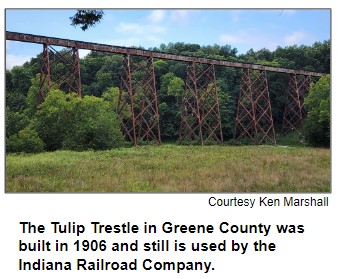 Guest Roadtripper and radio veteran and educator Ken Marshall certainly likes to see spectacular sites while wandering the back roads of Indiana. "Did someone give the Jolly Green Giant an erector set about 100 years ago? This creation is now rusty, but the Green Giant certainly built it well. This place is huge and long!"
Guest Roadtripper and radio veteran and educator Ken Marshall certainly likes to see spectacular sites while wandering the back roads of Indiana. "Did someone give the Jolly Green Giant an erector set about 100 years ago? This creation is now rusty, but the Green Giant certainly built it well. This place is huge and long!"
Ken is talking about the Tulip Trestle, a 2,307 feet long and 157 feet tall steel-girder railroad trestle built in 1906 and still in use today by the Indiana Railroad Company. It’s in Greene County southwest of Bloomington and near the small community of Tulip. Also known as the Viaduct, the trestle stretches from hill to hill across the beautiful Richland Creek Valley, making it one of the most memorable structures in Indiana.
Ken was able to safely take some photographs from a distance, but mercifully did not go out on the tracks to shoot. He noted that the most famous piece of graffiti there says "Michelle will you marry me?" right in the middle of the tracks. No one knows for sure if Michelle said "yes" or if the graffiti painter survived his escapade.
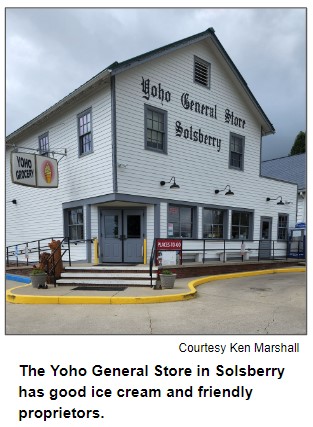
Ken also stopped at the Yoho General Store in nearby Solsberry for ice cream, where he said the proprietors were friendly. And to quote the famous bumper sticker displayed by both Glory-June Greiff of Indianapolis and Laura Malick of Baltimore, who are both historians who travel the back roads, "Not all who wander are lost."
Hoosier History Live looks back . .
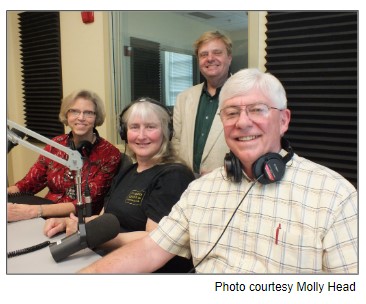 ...at our ''Postcards from Indiana'' show which aired live on August 15, 2015. Yes, back before Covid when we had multiple guests in the studio! Left to right are Libby Ciezniack, Glory-June Greiff, host Nelson Price, and Chuck Hazelrigg. Here’s the show enewsletter
...at our ''Postcards from Indiana'' show which aired live on August 15, 2015. Yes, back before Covid when we had multiple guests in the studio! Left to right are Libby Ciezniack, Glory-June Greiff, host Nelson Price, and Chuck Hazelrigg. Here’s the show enewsletter
And yes we have the show audio, but have not yet edited and posted a podcast. All this stuff we do costs money, folks! Consider visiting the yellow button on our website or enewsletter!
Molly Head, executive producer (317) 506-7164
Ryan DeRome, associate producer
Cheryl Lamb, administrative manager
Richard Sullivan, senior tech consultant
Pam Fraizer, graphic designer
Kathleen Madinger Angelone, Garry Chilluffo, consultants
"...best Americana-themed show..."
"Hoosier History Live is the best Americana-themed show anywhere on radio!"
- John Guerrasio, former IRT actor
"...fun and interesting..."
"Hoosier History Live is a fun and interesting way to learn about the heart and soul of Indiana. No boring classes or books here! The production team does an outstanding job."
- Judy O'Bannon, civic leader and public broadcasting producer
Please tell our sponsors that you appreciate their support!

 Acknowledgments to WICR-FM, Fraizer Designs, The Indiana Album, Monomedia, Indiana Historical Bureau, Indiana Landmarks, Henri Pensis, Kielynn Tally, Genesis Brown, Leticia Vasselli, Heather McIntyre, and many other individuals and organizations. We are independently produced and are self-supporting through organizational sponsorship and through individual contribution at the yellow button on our newsletter or website. For organizational sponsorship, which includes logos, links, and voiced credits in the show, contact Molly Head at (317) 506-7164 or email her at molly@hoosierhistorylive.org. Our media reach continues to grow via podcasting.
Acknowledgments to WICR-FM, Fraizer Designs, The Indiana Album, Monomedia, Indiana Historical Bureau, Indiana Landmarks, Henri Pensis, Kielynn Tally, Genesis Brown, Leticia Vasselli, Heather McIntyre, and many other individuals and organizations. We are independently produced and are self-supporting through organizational sponsorship and through individual contribution at the yellow button on our newsletter or website. For organizational sponsorship, which includes logos, links, and voiced credits in the show, contact Molly Head at (317) 506-7164 or email her at molly@hoosierhistorylive.org. Our media reach continues to grow via podcasting.
© 2022 Hoosier History Live. All rights reserved.
|

